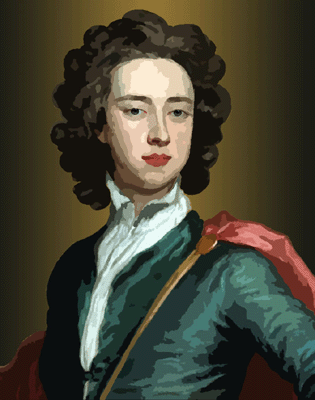 |
 |
|||
|
|
Charles was named
after his father, King Charles II. He was born in the house of his mother, Nell
Gwynne, in Lincoln's Inn Fields on 8th May 1670. It is said that,
one day when the King was with Nell, she called to the child, "Come
hither, you little bastard, and speak to your father." The next year, the Duke fulfilled one part of a general expectation of him, for, in 1688, he served in the Holy Roman Imperial army against the Turks, and was present at the taking of Belgrade on 20th August of that year. Meanwhile, the regiment of horse he commanded in England was placed under the command of Colonel Langston, who in November 1688 brought it to join the Prince of Orange. The Duke took his place in the House of Lords on 9th November 1691. On 17th May 1693, he left for Flanders and served under William III in the campaign of Landen. A false report even being brought to London that be had fallen in that battle. The Duke was a gallant soldier, and was highly esteemed by the King, who gave him many tokens of his regard. On his return from Flanders, William made him captain of the band of pensioners. He attempted to reform the corps but, on a complaint made by certain of the members the council, decided that it was to be kept on the same footing as it had been under Lord Lovelace, the last captain. In April 1694, the Duke married Lady Diana de Vere, daughter and sole heiress of Aubrey de Vere, the 20th and last Earl of Oxford. He served in Flanders as a volunteer in the July following and, the next month, received a pension of £2,000 a year from the Crown, half of which was paid out of the ecclesiastical first-fruits. The hereditary office of Master Falconer and the reversion of the office of Register of the High Court of Chancery had been granted him by his father. The reversion came to him in 1697 and was worth £1,500 a year. In the late Summer of that year, he was again with the King in Flanders when he received Peter the Great of Russia in Utrecht. Upon Beauclerkís return to England, after the conclusion of the Peace of Ryswick, King William gave him "a set of coach horses finely spotted like leopards" in appreciation of his services. In December 1697, he was sent to Paris to offer the King's congratulations on the marriage of the Duke of Burgundy with Mary Adelaide, daughter of Victor Amadeus II of Savoy. He had the good fortune, the next year, to escape from three highwaymen, who, on the night of 18th June, plundered between thirty and forty persons on Hounslow Heath, the Duke of Northumberland being among those attacked. These men attempted to attack the Duke of St. Albans, "but he was too well attended". In 1703, he received a further grant of £800 a year voted by the Parliament of Ireland. The Duke voted for the condemnation of Dr. Sacheverell and, consequently, on the triumph of the tory ministry, in January 1712, he was dismissed from his office of Captain of the Pensioners. He was, however, reinstated by King George I, and, in 1718, was made a Knight of the Garter. The Duke of St. Albans died in 1726 and his Duchess, who was a celebrated beauty, 1742. He was buried in Westminster Abbey and she in St. George's Chapel, Windsor. The two had eight sons: the eldest succeeded to his fatherís title; the third was created Lord Vere of Hanworth in 1750; the fourth, Henry, was a poverty-stricken MP who lived at Foliejon Park in Winkfield; the fifth, Sydney, a notorious fortune-hunter, was the father of the celebrated wit, Topham Beauclerk, both lived at Pilgrim Place in Windsor and Tyle Place in Old Windsor; the eighth son, Aubrey Beauclerk, was a famous naval captain during the War of the Austrian Succession. Edited from Leslie Stephen's 'Dictionary of National Biography' (1885).
|
|||
| © Nash Ford Publishing 2003. All Rights Reserved. | ||||



 Charles
Beauclerk,
Charles
Beauclerk,